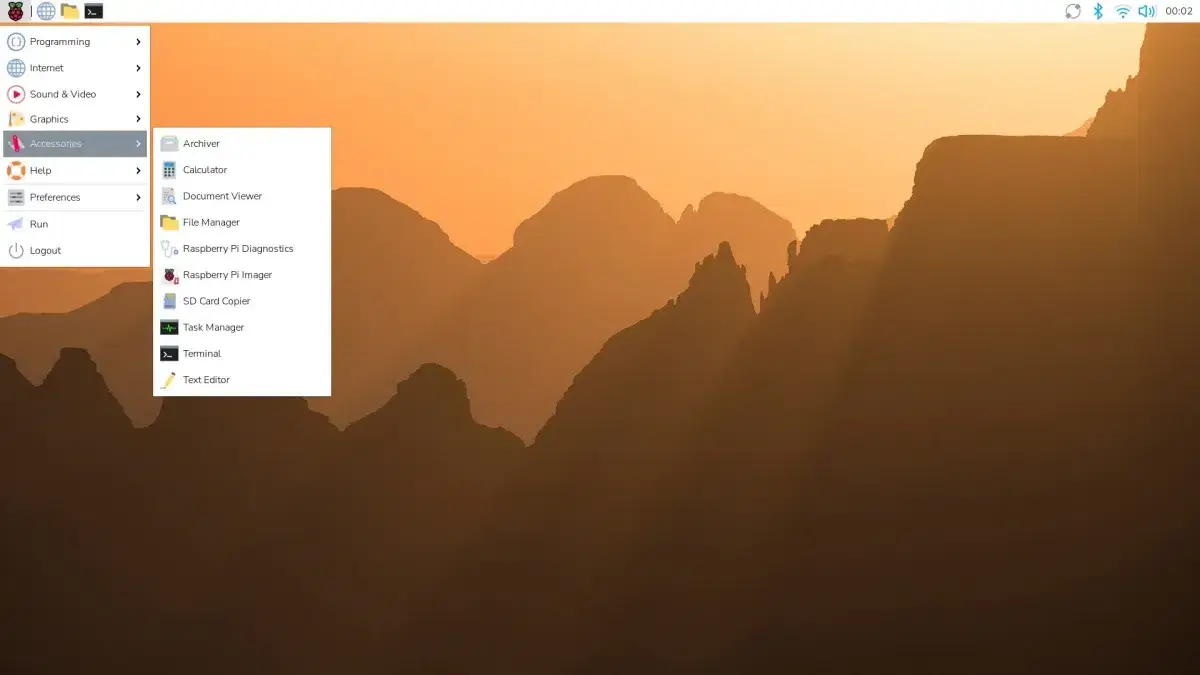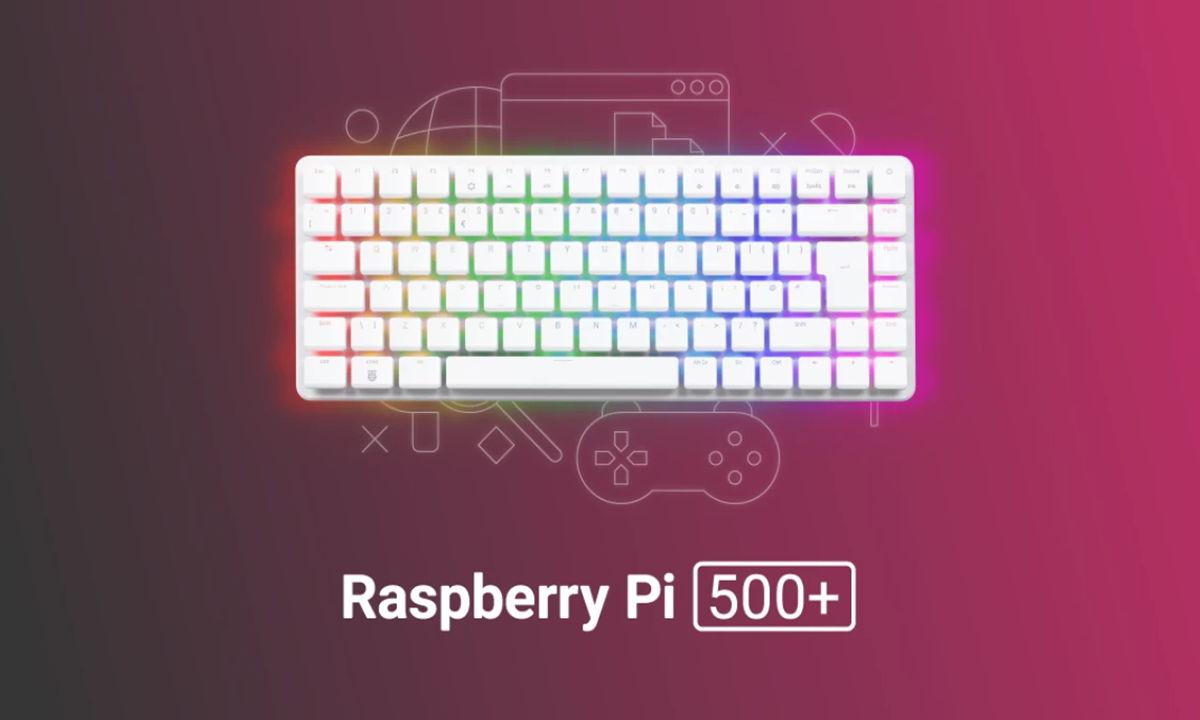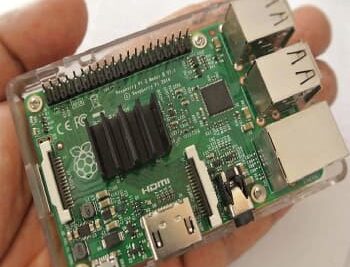- Raspberry Pi OS adopts Debian 13 with Linux 6.12 LTS and renewed design (PiXtrix/PiXonyx).
- New Control Center app with plugins and desktop packaged in metapackages.
- Improvements to panel, keyboard and apps; a clean install from Bookworm is recommended.
- Inherits key changes from Debian 13: /tmp in tmpfs, OpenSSH and sysctl tweaks.

The latest edition of Raspberry Pi OS takes an important step by settling on Debian 13 «Trixie», keeping the core Linux 6.12LTS and launching a much more polished desktop without any performance penalty. This base change opens the door to newer packages, deeper improvements (such as mitigations of the Y2038) and a more modular ecosystem.
Although updating existing facilities can be attempted, the foundation itself advises start from a clean install If you're coming from Bookworm, you'll want to take advantage of the new metapackage organization and avoid backlogs. However, if you're in a hurry, below we'll tell you how to safely test the beta via APT.
Key features of Raspberry Pi OS based on Trixie
The jump to the new Debian 13 base brings an up-to-date catalog, optimizations in different subsystems and a clear commitment to desktop modularity. All of this is based on Linux 6.12LTS, an extended support kernel that prioritizes stability with a steady trickle of fixes and support for hardwareRead the kernel news.
The visual aspect also changes skin: they appear two GTK themes renewed –PiXtrix (of course, by default) and PiXonyx (dark)–, a matching icon set (PiXtrix), a more legible typeface (Nunito Sans Light) and an updated background collection. This set makes the environment look more modern without losing its lightness.
Under the hood, the desktop image is broken down into metapackages so that it's easy for you to evolve from a minimal base to something more complete in two steps. This, added to a Control center unified by plugins, it simplifies both the initial installation and the daily configuration life.

Dashboard and desktop: plugins, order and cleanliness
The taskbar incorporates a system monitor with energy alerts and other critical events at a glance. In addition, the panels wf-panel-pi y lxpanel-pi They now share a clock plugin consistent, which reduces duplications and provides coherence.
The classic LXDE Panel is maintained by a specific fork, lxpanel-pi, in which unmaintained add-ons have been removed to win reliabilityThis deliberate cut favors the stability of the environment and reduces minor everyday annoyances.
Overall, the desk combines a more modern look and a very contained consumption, something key in a platform where the balance between aesthetics and efficiency is non-negotiable.
New Unified Control Center
System settings focus on the app Control Center, a lightweight core that loads functionality in the form of plugins. It replaces separate utilities such as Raspberry Pi configuration, Appearance, Mouse and keyboard, Screen settings and printer management, offering all in one window.
This modular approach supports third party extensions and custom pages for specific hardware or utilities. If a manufacturer wants to integrate their settings, they can do so without reinventing the wheel, which provides a flexibility unusual in such light environments.
Keyboard and menus: small, big improvements
Two tools are added terminal oriented to official keyboards: rpi-keyboard-config y rpi-keyboard-fw-update, designed for configure and update firmware where appropriate, and you can learn to Detect USB events in Linux to create automatic actions. They are accompanied by improvements to keyboard control in GTK apps and a thorough cleanup of the Main menu to make it more coherent.
These types of usability adjustments don't make any noise, but in the long run they make a difference: the desktop responds better, there is less friction and the whole thing is more consistent for new and veteran users.
Metapackages and installation paths
The desktop is laid out in blocks to facilitate gradual jumps; if you start from Raspberry Pi OS Lite, you can add a base environment with rpd-wayland-core (Wayland) or rpd-x-core (X11), and complete at your convenience with rpd-applications and the utility package rpd-utilities, for example for Build a retro console with Raspberry Pi.
Along with this modularity come up-to-date versions of Chromium and Firefox, and a reorganization of the desktop image packages. The goal is to make it easier for you to convert an installation Small in a complete (or vice versa) without dramas or rare cross-dependencies.
Apps and content: Bookshelf gets serious
La app Bookshelf It already distinguishes exclusive content for contributors and includes a button Contributing to unlock them. Recent titles are marked with a padlock icon If they are not available in your account, this perfectly clarifies what you can open now and what requires a subscription.
This dynamic encourages support for the ecosystem without hindering the reading experience of those who just want to explore open material or see what's new, and to the development of programs for Raspberry Pi.
Download, compatibility and installation methods
The Raspberry Pi OS image based on Debian 13 It is downloaded from the official site and you can burn it with Raspberry Pi Imager or similar tools to an SD card or USB drive. USB. Editions of 32 and 64 bits to cover more use cases and hardware. If you use PoE, check out How PoE works in networks.
Plate compatibility: 1A+, 1B+, 2B, 3B, 3B+, 3A+, 4B, 400, 500, CM1, CM3, CM3+, CM4, CM4S, Zero, Zero W and Zero 2 W. If you come from Bookworm, the official recommendation is to make a backup and perform clean installation of the new Trixie image to avoid drag and take advantage of the modular architecture from the first minute.
Performance and technical basis
The tandem Linux 6.12LTS + Debian 13 offers a very balanced foundation: improved desktop responsiveness, more modern libraries and packages, and internal changes geared towards long-term maintainabilityWithout selling smoke, there is a greater fluidity in everyday use.
The combination of the new Control center, the reorganization by metapackages and the commitment to updated themes and icons puts Raspberry Pi OS where it should be: a system light, clear and extensible that you can fine-tune whether you're starting from scratch or coming from a minimal setup.
How to beta test by editing APT (cautiously)
If you're curious and prefer to try Trixie without reinstalling, you can force the update via APT. Remember, though, that it's for testing only and that the most sensible option for production is the clean installation recommended by the project.
Summary steps: Update your current system first, reboot if applicable, and then edit your repositories to point to trixie. After that, run a full update and finish with a dist-upgrade. Broadly speaking, the flow would be:
- Update the present:
sudo apt updateysudo apt upgrade -y(if a lot of packages come in, restart). - Edit repos in
/etc/apt/sources.listand in/etc/apt/sources.list.d/raspi.list, substituting bookworm by trixie on all lines (including trixie-updates y trixie-security). - Update indexes and packages:
sudo apt update& AFTERsudo apt upgrade(there will be confirmations and notifications of configuration changes). - Complete dependencies and transitions with
sudo apt dist-upgradeto fit in all the pieces of the new release. - Reboot to apply global changes and finally free up space with
sudo apt autoremoveysudo apt autoclean.
We insist: it is not the path recommended by the foundation, but it works for tinker and take the pulse of the system before taking the leap with a clean image.
Warnings and legacy changes from Debian 13 that may affect you
Raspberry Pi OS follows the Debian cycle and, with Trixie, inherits several general changes that are worth knowing. Below is a review of the most relevant ones with a practical impact on royal facilities:
- OpenSSH and remote updates: There is an issue in Bookworm that can block reconnections if a remote update is interrupted. SSHBefore migrating, make sure you have OpenSSH 1:9.2p1-2+deb12u7 or higher via stable-updates.
- i386 is no longer a normal architecture: there is no official kernel or i386 installer; it is reserved for legacy code via multiarch or chroot on amd64. Doesn't apply to the Pi, but may affect auxiliary tools.
- armel, last update: Trixie is the last one for armel; only Pi 1, Zero and Zero W still have kernel package support. Consider reinstalling as armhf or arm64 when it is possible.
- MIPS removed: mipsel y mips64el disappear from Debian; relevant if you compile for external devices.
- /boot larger: the kernel and firmware have grown; make sure that
/boothave at least 768 MB and about 300 MB free or the update may fail. - /tmp now in tmpfs: by default it is mounted in memory (up to the 50%. available). Gain speed, but be careful when dumping large files there. You can revert it in
tmp.mounto/etc/fstab. - OpenSSH no longer reads
~/.pam_environment: moves variables to~/.bashrcor equivalent mechanisms; subtle changes in new SSH sessions. - DSA Keys Out: OpenSSH 9.8p1 no longer supports DSA even when enabling them; use Ed25519/ECDSA/RSA. For older DSA-only devices, there is
ssh1(package openssh-client-ssh1). - last/lastb/lastlog: make way for wtmpdb, lastlog2 y
lslogins. If you do not migrate to wtmpdb, delete/var/log/wtmp*after update. - Encrypted disks: self-decryption is now systemd-cryptsetup (installed as recommended). In dm-crypt plain change the default values; if you created them in Bookworm, leave them fixed cipher=aes-cbc-essiv:sha256,size=256,hash=ripemd160 en
/etc/crypttabor they won't ride. - RabbitMQ: HA queues replaced by quorum queuesThere is no direct upgrade path from Bookworm; after upgrading to Trixie, you sometimes have to clean up
/var/lib/rabbitmq/mnesia. - MariaDB: Major version jumps require clean shutdown previous; otherwise, the new server will refuse to start until it recovers to the previous version.
- sysctl: systemd-sysctl he no longer reads
/etc/sysctl.conf. Arrives linux-sysctl-defaults/usr/lib/sysctl.d/50-default.conf. Your local settings go in/etc/sysctl.d/*.conf. - Unprivileged ping: now uses datagram sockets; access depends on
net.ipv4.ping_group_range. In normal installations it leaves it permissive the default sysctl package. - NIC names: may vary with systemd v257 (i40e or ACPI _SUN driver). Check it before rebooting with
udevadm test-builtin net_setup_linkand sets names with systemd.link if you need stability. - Dovecot 2.4: incompatible configuration format; the replicator disappears. Test the configuration in a different environment. Non-productive before.
- Libvirt: drivers and backends in separate packagesAfter updating, check which binaries you have installed and clean up any leftovers. You may see files marked as obsolete.
- Samba: AD-DC moves to samba-ad-dc; ceph and gluster VFS modules go to dedicated packages (samba-vfs-ceph y samba-vfs-glusterfs).
- OpenLDAP: Now your TLS goes with OpenSSL (not GnuTLS). Options and behavior change; if you don't specify a CA, the system's trust base will be loaded.
- Bacula: The schema change is huge; it can take hours or days and requires about double the space temporary on the DB server.
- usrmerge: you will see warnings from
dpkgwhen updating; ignore them, it's normal when the project ends. - Don't skip versions: complete the update to Bookworm before starting Trixie's.
- WirePlumber: New configuration system; if you customize, check
/usr/share/doc/wireplumber/NEWS.Debian.gz. - strongSwan: migrates from charon-daemon a charon-systemd swanctl and config in
/etc/swanctl/conf.d. - sg3-utils: missing udev properties can break streams with SCSI devices that depend on sg3-utils-udev.
- tzdata-legacy: Non-standard time zones are separated; if your system or services use them, install tzdata-legacy.
- Cleaning of
/tmpy/var/tmp: On new installations, old files (10 and 30 days) are deleted. When upgrading, a rule is created to maintain the classic behavior; you can change this in tmpfiles.d. - Systemd message unmerged-bin: ignore it; merge manually
/usr/biny/usr/sbinbreak future updates. - Browser Security: webkit2gtk covered with patches, but qtwebkit No. For general use, Firefox or Chromium ESR recompiled for stable is best.
- Go/Rust: Limited security coverage via static linking; some fixes coming via minor updates.
- QEMU ppc64el: be careful with page sizes; if the guest needs 4 KiB, use
cap-hpt-max-page-size=4096; if 64 KiB, install linux-image-powerpc64le-64k. - Notable deprecated packages: libnss-gw-name (USA libnss-myhostname), pcregrep (USA
grep -Po pcre2grep), request-tracker4 (migrate to request-tracker5), git-daemon-run/sysvinit, nvidia-graphics-drivers-tesla-470, deborphan (USAapt autoremoveyapt-mark minimize-manual), tldr (replaceable by tealdeer o tldr-py), Tpp (alternatives lookatme, fries). - Looking ahead to Debian 14: sudo-ldap will be withdrawn (usa libsss-sudo), possible withdrawal of sudo_logsrvd, libnss-docker may crash due to deprecated API, OpenSSH without GSS-API by default (uses packages -gssapi if you need it), end of sbuild-debian-developer-setup in favor of sbuild+unshare, goodbye to fcitx 4.x (migrate to fcitx5), lxd replaced by incus, isc-dhcp deprecated (Kea on servers; NetworkManager/systemd-networkd or dhcpcd-base in clients), end of development of KDE 5 (exit during forky cycle).
- Known serious bugs at the time of publication: these include, among others, #1032240, #1078608, #1108467, #1109499, #1108010, #1102690, #1109509, #1110119, #1036041, #1102160, #913916, #984760, #1099655, #935182, #1017906, #1109203, #1109676, #1109512, #1104231, #1084955, #1104177, #1104336, #1084954, #1095866, #1100981, #1109519, #1110263, #1108039, #1089432, #1101956, #1101839, #1017891, #1109833, #988477. Check the BTS for updated status.
Raspberry Pi 500+: New hardware that fits Trixie
The house also presented Raspberry Pi 500+, an evolution of the keyboard PC concept that increases performance and adds very attractive details. Inside it is a Broadcom BCM2712 quad-core Cortex‑A76 processor clocked at 2,4 GHz and a VideoCore VII GPU with support for OpenGL ES 3.1 and Vulkan 1.2, accompanied by 16 GB LPDDR4x‑4267, storage M.2 2280 with SSD 256 GB and microSD reader.
The grace is in the keyboard: abandon the membrane for Gateron KS‑33 Blue mechanical keys with RGB backlighting, and each key integrates a RP2040 running open QMK firmware. Customization is immense and compatible with most switches from the market, an obvious nod to the more coffee-loving public.
In terms of connectivity, it does not fall short: Wi‑Fi and Bluetooth integrated, two micro-HDMI up to 4K, three USB-A, Gigabit Ethernet and the usual 40-pin GPIO. It costs around $200 (the Desktop Kit For 20 more, add an official mouse, 27 W USB-C power supply and micro-HDMI cable) and the company guarantees production and spare parts at least until 2035Obviously, the recommended system is Raspberry PiOS based on Trixie, also ideal for running Kodi.
Post-installation and customization tips (optional)
If you're keen to get your system running smoothly, here are a few quick suggestions that work with Debian 13 and the new Raspberry Pi OS. They're not mandatory, but they help. complete the experience:
- Network and Terminal: Configure the network if it wasn't ready during installation; customize the terminal (dark theme, shortcuts) Ctrl+C/V to copy/paste) to work more comfortably.
- Privileges: If it is useful to you, add your user to sweats temporarily to streamline administrative tasks (remember to revert if you don't need it).
- Mounting discs: use
blkidfor UUID and declare your records in/etc/fstab(for example, riding in/mntext4 defaults 0 0). - Basic security: install ufw/gufw as firewalls and clamav/clamtk for a spot scan. Keep your system up to date and services to a minimum.
- Users and virtualization: separate profiles by tasks or strip Virtual machines VirtualBox, Virt-Manager/QEMU o VMware (proprietary) for risk-free testing.
- 3-2-1 Copies: Three copies, two different media, and one away from home. Tools such as Rsync o NAS type solutions They simplify your life.
- Pi-hole: If you want to block ads/telemetry at the network level, Pi-hole works like a charm on a Raspberry Pi. Remember to disable DHCP in the router if you assume it from Pi-hole and adjust lists gravity with head.
For the visual layer in GNOME (if you use this environment), install synaptic and tools like gnome-shell-extensions-manager and the package gnome-shell-extensionsVery useful extensions: dash-to-panel, caffeine, weather, desktop-icons-ng, apps-menu y window-list; if you prefer dock, dash-to-dockA good resource for themes and icons is Gnome-look.
In fonts, font-manager y font-viewer They make your life easier. Recommended packages: fonts-linuxlibertine, fonts-recommended. For non-Latin languages: fonts-ancient-scripts (old), fonts-babelstone-han (Chinese), fonts-baekmuk (Korean), fonts-noto-core/extra (massive coverage) or fonts-sil-taiheritagepro (Vietnamese). For office compatibility, install ttf-mscorefonts-installer and, if you need, sources like gauges o Cambria from an origin with valid license.
Repositories and software: review /etc/apt/sources.list in order to have trixie with relevant components (main, non-free-firmware, etc.) and updates with apt. External repos such as deb‑multimedia can fix certain thumbnails, but use them wisely. Browsers like Free wolf They have their own repos; follow their instructions to avoid conflicts.
Packaging alternatives: Flatpak y Snap are useful if you can't find a working native package. Install flatpack and, if you want, integrate with gnome-software. In Flatub you will find the installation command for almost everything popular.
Loose packages: with dpkg -i you install .deb (if any dependencies are missing, resolve them and try again). Tarballs like those from Anki They usually include script installation; others such as Waterfox allow to be executed from /opt, adding a .desktop en ~/.local/share/applications. Adjust permissions with chown/chmod if necessary. The AppImage are even simpler: give them execution permission and that's it.
Compiling from source is still a valid option for projects that do not package (e.g., GNU IceCat). And to adjust tools, a practical example: mPV. You can create ~/.config/mpv/input.conf for shortcuts (volume, forward/backward, screenshots) and ~/.config/mpv/mpv.conf for options like autofit o geometry, achieving a behavior very personalIf you're just starting out, a good foundation is a Introduction to Python Programming.
For the browser, they are valid Tricks known: ublock origin, telemetry control, profiles differentiated by task and, if you like, separate markers by work context in different browsers (Firefox, Chromium, LibreWolf, Waterfox). It's more manual, but it avoids mixing habits and data.
With all this you have a well-established Raspberry Pi OS based on Trixie: light, modern and tidyBetween the base jump, the metapackages, the Control Center, and the interface overhaul, it's a good time to take the plunge if you want a more polished experience without sacrificing the platform's frugal philosophy.
Passionate writer about the world of bytes and technology in general. I love sharing my knowledge through writing, and that's what I'll do on this blog, show you all the most interesting things about gadgets, software, hardware, tech trends, and more. My goal is to help you navigate the digital world in a simple and entertaining way.
